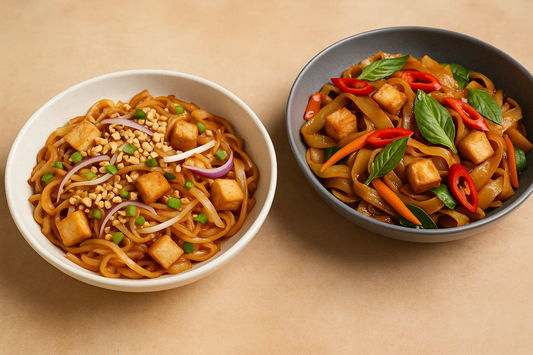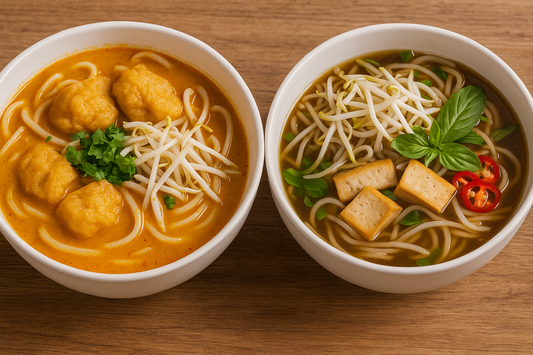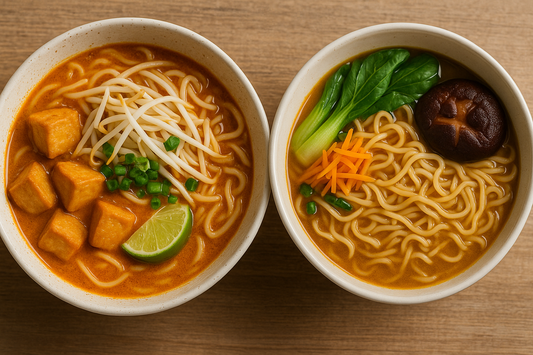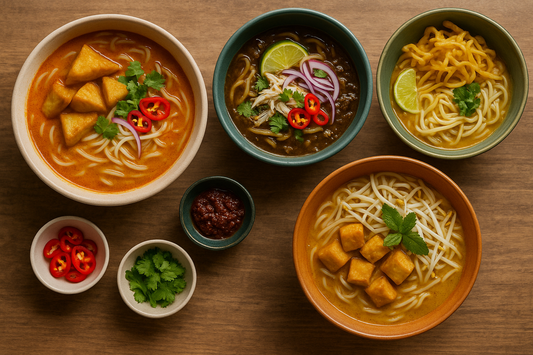Jajangmyeon is a popular Korean dish that has captured the hearts and taste buds of people all around the world. In this ultimate guide, we will dive deep into the origins, cultural significance, key ingredients, and even explore how to make this delicious dish at home. So, whether you're a Jajangmyeon enthusiast or someone looking to broaden their culinary horizons, this guide is for you.
Understanding the origins of Jajangmyeon
The history of Jajangmyeon is deeply entwined with the rich cultural tapestry of Korea. To truly appreciate this dish, it is important to understand its origins and the influences that shaped its development.
Jajangmyeon holds a special place in Korean culinary history, symbolising the fusion of Chinese and Korean flavours. This iconic dish has become a staple in Korean cuisine, loved by locals and visitors alike. Its journey from a humble Chinese immigrant dish to a Korean comfort food classic is a testament to the power of cultural exchange and adaptation.
The Chinese influence on Jajangmyeon
Jajangmyeon owes its roots to Chinese cuisine. It was introduced to Korea during the late 19th century by Chinese immigrants residing in Incheon, a major port city in Korea. These immigrants brought with them their culinary traditions, including a dish known as Zhájiàngmiàn. Over time, this Chinese dish evolved into what we now know as Jajangmyeon, incorporating Korean flavours and techniques.
The adaptation of Zhájiàngmiàn into Jajangmyeon showcases the creativity and resourcefulness of Korean cooks. By infusing local ingredients and spices, they transformed a foreign dish into a uniquely Korean delicacy. The thick, savoury black bean sauce that defines Jajangmyeon today is a testament to this harmonious blend of culinary traditions.
How Jajangmyeon became a Korean staple
As Jajangmyeon blended Chinese and Korean culinary elements, it gained popularity among the Korean population. Its affordable and filling nature made it a favoured choice for many during difficult times. Today, Jajangmyeon is not only a beloved street food but also a must-have dish for special occasions and celebrations.
From its humble beginnings in the streets of Incheon to its status as a national favourite, Jajangmyeon has captured the hearts and taste buds of Koreans for generations. Its enduring popularity is a testament to the cultural significance of food in Korean society, where meals are not just sustenance but a reflection of history, tradition, and community.
The cultural significance of Jajangmyeon
Beyond its delicious taste, Jajangmyeon holds a special place in Korean culture. It has become an iconic dish that symbolises various aspects of Korean society.
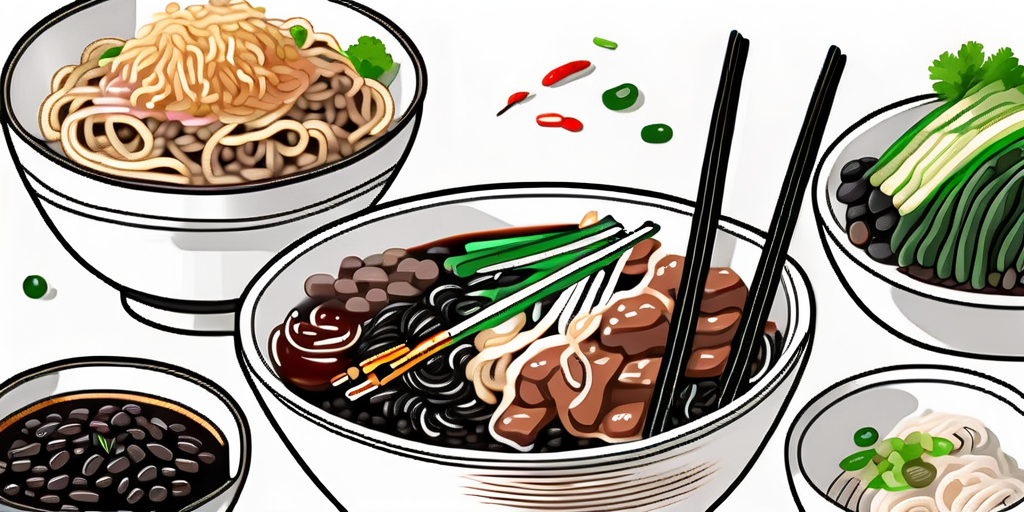
Jajangmyeon, a popular Korean-Chinese noodle dish, has a rich history dating back to the early 20th century when Chinese immigrants introduced it to Korea. The dish consists of thick, chewy noodles topped with a savoury black bean sauce, mixed with diced pork, onions, and other vegetables. Its unique flavour profile and satisfying texture have captured the hearts of Koreans for generations.
Jajangmyeon in Korean media and pop culture
Jajangmyeon has made its way into the heart of Korean television dramas, movies, and even K-pop songs. It has become a cultural symbol, often depicted as a comfort food that brings people together.
In popular culture, Jajangmyeon is frequently portrayed as a dish that evokes feelings of nostalgia and warmth. Its appearance in various forms of media has solidified its status as a beloved culinary icon in South Korea. Whether enjoyed by characters in a romantic scene or shared among friends during a light-hearted moment, Jajangmyeon has transcended its culinary roots to become a cultural phenomenon.
The role of Jajangmyeon in special occasions
From birthdays to graduations, Jajangmyeon takes centre stage in celebrating special moments. It has become a tradition to share a plate of Jajangmyeon with loved ones, signifying the joy and togetherness that accompanies these occasions.
During festive occasions such as Lunar New Year or Chuseok (Korean Thanksgiving), families often gather around the dining table to enjoy a hearty meal together, with Jajangmyeon being a staple dish on the menu. The act of sharing this dish not only represents the importance of familial bonds but also highlights the cultural significance of food as a unifying force in Korean society.
The key ingredients in Jajangmyeon
At the heart of Jajangmyeon are the essential ingredients that give this dish its distinct flavour and character.
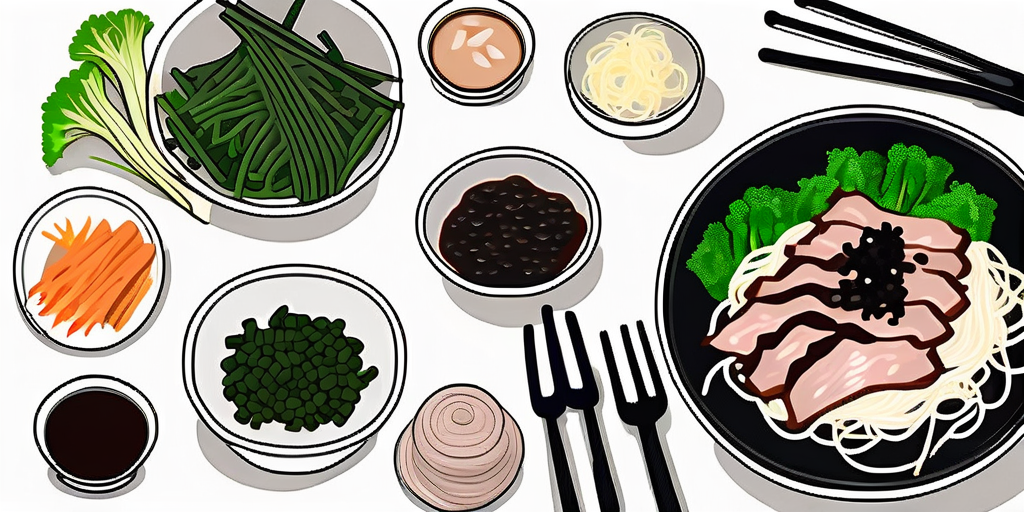
Jajangmyeon, a popular Korean-Chinese noodle dish, boasts a history as rich as its flavour. Originating from the Chinese dish Zhajiangmian, Jajangmyeon has been adapted over the years to suit Korean palates, resulting in a unique and beloved dish that is enjoyed by many.
The importance of black bean paste
Black bean paste, also known as chunjang, is the star ingredient of Jajangmyeon. It is made from fermented soybeans and caramel, giving the dish its signature dark colour and rich umami taste.
Chunjang undergoes a meticulous fermentation process, allowing the flavours to develop and intensify over time. The depth of flavour that chunjang imparts to Jajangmyeon is unparalleled, making it a crucial component that cannot be substituted.
The role of noodles in Jajangmyeon
Jajangmyeon noodles are thick and chewy, providing the perfect base for the delectable black bean sauce. Made from wheat flour, these noodles add texture and satisfaction to each bite.
The noodles used in Jajangmyeon are specially chosen for their ability to hold the thick black bean sauce, ensuring that each mouthful is a harmonious blend of flavours and textures. The chewiness of the noodles complements the richness of the sauce, creating a truly comforting and satisfying dish.
The art of making Jajangmyeon at home
While enjoying Jajangmyeon at a local restaurant is a delightful experience, making it at home allows you to tailor the dish to your preferences and create lasting memories in the process.
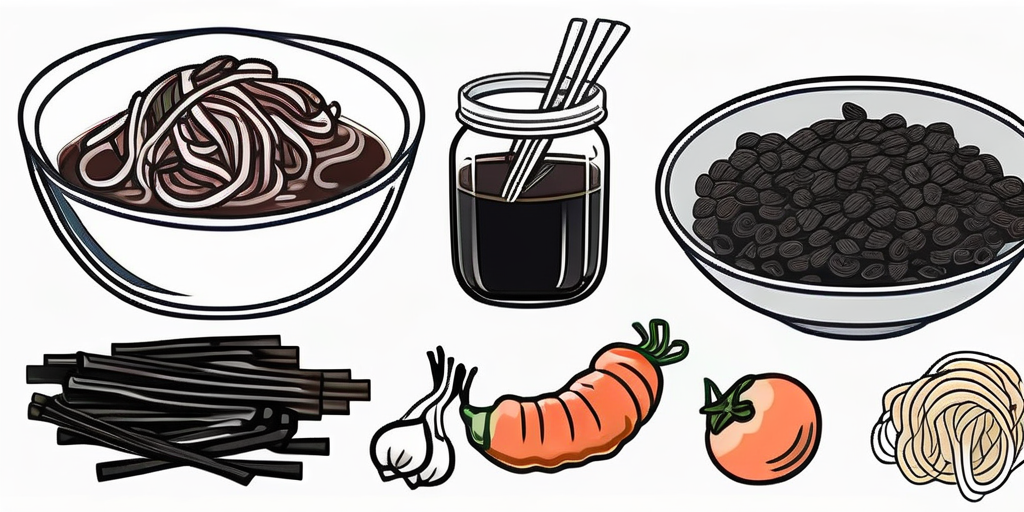
Originating from China and adapted in Korea, Jajangmyeon is a popular noodle dish featuring a savoury black bean sauce mixed with various ingredients. The dish has a rich history and is beloved by many for its comforting and satisfying flavours.
Preparing the ingredients
Before you embark on your Jajangmyeon journey, it's important to gather the necessary ingredients and prepare them with care. From slicing vegetables to marinating meat, each step contributes to the final flavour of the dish.
Take the time to source high-quality ingredients such as pork belly, onions, zucchini, and potatoes. The marriage of these fresh components is crucial in creating a harmonious blend of textures and tastes in your homemade Jajangmyeon.
Cooking the perfect Jajangmyeon
The key to achieving a delicious Jajangmyeon lies in the cooking process. From stir-frying the black bean paste to simmering it with other ingredients, the careful balance of flavours is paramount. With precise timing and attention to detail, you'll soon be savouring a homemade bowl of Jajangmyeon that rivals your favourite restaurant.
As the sauce thickens and coats the chewy noodles, the aroma that fills your kitchen will transport you to the bustling streets of Seoul, where Jajangmyeon is a beloved staple in Korean cuisine. The satisfaction of creating this iconic dish from scratch is a rewarding experience that will have you coming back to your kitchen time and time again.
Exploring variations of Jajangmyeon
Just like any beloved dish, Jajangmyeon has evolved over time to accommodate regional preferences and modern twists.
Jajangmyeon, a popular Korean-Chinese noodle dish, has a rich history that dates back to the early 20th century when it was introduced to Korea by Chinese immigrants. Over the years, this dish has undergone various transformations, leading to the diverse range of interpretations we see today.
Regional differences in Jajangmyeon recipes
In different regions of Korea, you'll find unique interpretations of Jajangmyeon. From the addition of seafood in coastal areas to the use of different vegetables, exploring these regional variations is a culinary adventure.
In the bustling streets of Incheon, a coastal city known for its fresh seafood, you may come across a tantalising version of Jajangmyeon that includes succulent prawns or tender pieces of squid. On the other hand, in the mountainous region of Gangwon, you might find Jajangmyeon recipes that feature earthy mushrooms and hearty root vegetables, reflecting the local produce available.
Modern twists on the traditional Jajangmyeon
For those seeking innovative flavours, modern twists on Jajangmyeon offer exciting possibilities. From fusion variations that incorporate elements of other cuisines to vegetarian or vegan options, the possibilities are endless.
For the adventurous food enthusiast, exploring modern twists on Jajangmyeon can lead to delightful discoveries. Imagine savouring a Mexican-inspired Jajangmyeon with a hint of smoky chipotle peppers or indulging in a plant-based version made with tofu and shiitake mushrooms for a wholesome twist on the classic dish.
Now armed with the ultimate knowledge of Jajangmyeon, you can embark on a culinary adventure to experience and savor this iconic Korean dish. Whether you're making it at home or indulging in a bowl at a restaurant, Jajangmyeon is sure to leave its mark on your taste buds and your heart.
Ready to take your love for Jajangmyeon to the next level? Pam Pam offers a delectable range of plant-based Asian ready meals, including twists on your favourite classics. Our meals are crafted with authentic ingredients and aromatic spices, ensuring a delicious and convenient dining experience. Perfect for those busy days or when you crave a taste of Korea at home, our meals are snap-frozen to lock in the flavour and nutrients. Embrace the ease and satisfaction of plant-based goodness with Pam Pam. Shop online today and indulge in the ultimate comfort food that's ready when you are.






